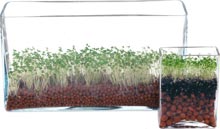Which Foods are Most Likely to Make You Sick?
The 10 Riskiest Foods Revealed
by www.SixWise.com
This summer’s massive egg recall, prompted by thousands of cases of Salmonella poisoning, is now safely behind us, but there are still foods lurking in your supermarket that have the potential to make you sick.
Food-borne diseases cause an estimated 76 million illnesses, 325,000 hospitalizations and 5,000 deaths in the United States each year, according to the U.S. Centers for Disease Control and Prevention.
In all, about 200 diseases can be transmitted through food, including via viruses, bacteria, parasites, toxins, metals and prions. Most deadly, however, are bacteria, which account for 72 percent of food-related deaths, followed by parasites (21 percent), and viruses (7 percent). And though there are countless organisms that can make you ill, just five pathogens are responsible for 90 percent of food-related deaths each year. These include:
- Salmonella (31 percent)
- Listeria (28 percent)
- Toxoplasma (21 percent)
- Norwalk-like viruses (7 percent)
- Campylobacter (5 percent)
E. coli O157:H7 accounts for an additional 3 percent of deaths.
Which Foods are Riskiest?
It’s possible to get food poisoning from virtually any food in today’s modern food system, and with the mass production of food nowadays it’s common for a batch of contaminated food to quickly get spread across the entire country.
Not only does this make it difficult to trace the pathogen back to its source, it often takes longer to determine where the contaminated foods were distributed -- which means more people may get sick.
Often, the foods that are most likely to be contaminated may be those you least suspect. In fact, the Center for Science in the Public Interest, which analyzed data from foodborne-illness outbreaks from 1990 to 2006, revealed exactly which FDA-regulated foods are most often contaminated … and their findings may surprise you:
 1. Leafy Greens – 363 outbreaks
1. Leafy Greens – 363 outbreaks
Responsible for nearly 30 percent of the illnesses linked to the Top 10 Most-Contaminated list, leafy greens were found to contain varying pathogens, ranging from E. coli O157:H7, which caused several deaths, to Norovirus and Salmonella.
Leafy greens can become contaminated from contact with wild animals, manure, contaminated water, or poor handling during harvest, according to CSPI. They can also be contaminated during the pre-wash process used for bagged lettuce, as the washing systems themselves can transfer bacteria from one batch of lettuce to the next.
 2. Eggs – 325 outbreaks
2. Eggs – 325 outbreaks
As you might suspect, most cases of egg contamination were due to Salmonella, which can reach eggs via animal feces or directly from an infected hen’s ovaries. While cooking and proper storage can destroy Salmonella, about half of the outbreaks occurred in restaurants where eggs may have been served raw or runny, or left on buffets at improper temperatures.
 3. Tuna – 268 outbreaks
3. Tuna – 268 outbreaks
You’ve likely heard of the warnings regarding heavy metals like mercury in your tuna, but you may not be familiar with scombroid poisoning, which is caused by the Scombrotoxin in tuna. This toxin is released when fresh fish are stored above 60 degrees Fahrenheit, and can cause headaches, cramps, nausea, diarrhea, palpitations, and loss of vision in humans. Scombrotoxin caused the most illnesses related to tuna, however Norovirus and Salmonella were also implicated.
 4. Oysters – 132 outbreaks
4. Oysters – 132 outbreaks
Even though oysters comprise only a small amount of the American diet, they rank highly on the food-contamination list. Norovirus, which can live in waters where oysters are harvested, is common in oysters, as is Vibrio, a bacteria that’s in the cholera family.
Eating food infected with Vibrio causes diarrhea, abdominal cramping, nausea and headache. In people with weakened immune systems, certain varieties of Vibrio can infect the bloodstream and be life-threatening.
 5. Potatoes – 108 outbreaks
5. Potatoes – 108 outbreaks
Since potatoes are always cooked before eating, contamination usually occurs when potatoes are used as part of a recipe, such as potato salad. Salmonella and E. coli in these dishes are often due to cross contamination from raw ingredients, while Shigella may be transmitted from improper handling. Listeria in potato dishes is also relatively common, as Listeria may live in deli areas where potato salads are made.
 6. Cheese – 83 outbreaks
6. Cheese – 83 outbreaks
Cheese may be contaminated with Salmonella or Listeria, which can get into the product during production or processing. Listeria is especially dangerous for pregnant women, as it can cause miscarriage without the mother experiencing symptoms. For this reason, pregnant women are advised to avoid soft cheeses (feta, Brie, Camembert, blue-veined and Mexican-style cheese), which are more likely to carry the bacteria, especially if unpasteurized.
 7. Ice Cream – 75 outbreaks
7. Ice Cream – 75 outbreaks
Ice cream can contain Salmonella or Staphylcoccus, and most outbreaks are linked to homemade ice cream made in private homes. The ice cream can also be contaminated via cross contamination during processing. Soft-serve ice cream may also be a risk, as Listeria can live on metal surfaces in soft-serve ice cream machines, thereby contaminating batch after batch.
 8. Tomatoes – 31 outbreaks
8. Tomatoes – 31 outbreaks
Salmonella, which can enter a tomato plant through its roots or flowers, as well as through cracks on the skin, the stem scar or through the plant itself, was responsible for over half of the tomato outbreaks. Norovirus can also contaminate tomatoes. Most often illnesses occur after eating contaminated tomatoes in restaurants.
 9. Sprouts – 31 outbreaks
9. Sprouts – 31 outbreaks
Sprout seeds can become contaminated with Salmonella or E. coli during storage, then spread under the warm, humid growing conditions. Improper handling during production has also caused outbreaks. Because sprouts pose a contamination hazard, both the CDC and the FDA recommends that people with compromised immune systems, the elderly and young children not consume raw sprouts.
 10. Berries – 25 outbreaks
10. Berries – 25 outbreaks
Cyclospora in berries causes a parasitic illness of the intestines that can cause severe diarrhea, cramps and dehydration and requires antibiotics to treat. While this is the most common cause of contamination, one major outbreak occurred in 1997 after frozen strawberries were contaminated with Hepatitis A, likely from an infected farm worker.
What Can You to do Reduce Your Risk?
Even with the best intentions and hygiene it’s still possible to be exposed to a contaminated food. And this is why many natural health experts recommend keeping your digestive system in top working order at all times.
Why? Because 70 percent of your immune system is located in your digestive system, which means that if your gut is overrun with bad bacteria, there’s a good chance your immune system will not be functioning at its best.
On the other hand, if your gut is being fortified with good bacteria, or probiotics, your immune system will be fully functioning and have the best chance of fighting off any disease-causing bacteria it encounters.
In choosing a probiotic supplement for yourself, Sixwise.com highly recommends AbsorbAid Probiotic from NutritionsFinest.com -- a superlative probiotic supplement that provides clinical activities supporting systemic health and wellness through immune-system protection, allergy reduction and effective and enhanced nutrient absorption.
AbsorbAid Probiotic has 30 billion organisms per capsule, with two clinically effective and dominant genera Bifidobacterium and Lactobacillus: L. acidophilus and L. salivarius in a 2:1 ratio and B. lactis and B. breve, also in a 2:1 ratio. Each bacterial genus-species has its own specific metabolic activities, which lead to their effective inter-species synergism.
Probiotics not only help to keep your digestive health in working order, but they may also help you to ward off food poisoning if you get it. According to one study by Irish scientists, pigs receiving probiotics had reduced incidence, severity and duration of diarrhea after being infected with salmonella.
So if you suspect you have come down with a food-borne illness, having probiotics on hand and taking a generous dose is a simple, and safe, remedy to try. However, if your symptoms persist make sure to see your doctor.
You can further reduce your food-poisoning risk by following these tips from the Mayo Clinic and other experts:
- Wash your hands, utensils and food surfaces often.
- Keep raw foods separate from ready-to-eat foods when shopping, preparing food or storing food.
- Cook foods to a safe temperature. You can kill harmful organisms in most foods by cooking them to temperatures between 145 F (62.8 C) and 165 F (73.9 C).
- Keep foods hot or refrigerated until serving.
- Only eat shellfish, such as oysters, that has been thoroughly cooked, particularly in the warm-weather months when related infections are more common.
- Refrigerate or freeze perishable foods promptly (within two hours of purchasing or preparing them).
- Defrost food safely. Do not thaw foods at room temperature. The safest way to thaw foods is to defrost foods in the refrigerator or to microwave the food using the "defrost" or "50 percent power" setting. Running cold water over the food also safely thaws the food.
- Throw it out when in doubt. If you aren't sure if a food has been prepared, served or stored safely, discard it.
Recommended Reading
6 Types of Very Common Toxic Bacteria You Need to Avoid, and Where They're Typically Found
How Long Before Different Refrigerated Foods Spoil (& Other Secrets to Your Refrigerator)
Sources
CSPInet.org October 6, 2009
The Ten Riskiest Foods Regulated by the U.S. Food and Drug Administration, Center for Science in the Public Interest (PDF)
CDC.gov Emerging Infectious Diseases Vol. 5, No. 5 September-October
MayoClinic.com Food Poisoning